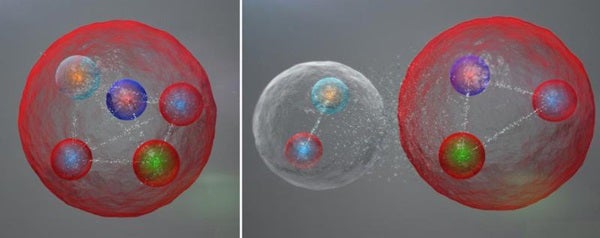“The pentaquark is not just any new particle,” said LHCb spokesperson Guy Wilkinson. “It represents a way to aggregate quarks, namely the fundamental constituents of ordinary protons and neutrons, in a pattern that has never been observed before in over 50 years of experimental searches. Studying its properties may allow us to understand better how ordinary matter, the protons and neutrons from which we’re all made, is constituted.”
Our understanding of the structure of matter was revolutionized in 1964 when American physicist Murray Gell-Mann proposed that a category of particles known as baryons, which includes protons and neutrons, are composed of three fractionally charged objects called quarks, and that another category, mesons, are formed of quark-antiquark pairs. Antiquarks are quarks of antimatter. Gell-Mann was awarded the Nobel Prize in physics for this work in 1969. This quark model also allows the existence of other quark composite states, such as pentaquarks composed of four quarks and an antiquark.
Earlier experiments that have searched for pentaquarks have proved inconclusive. Where the LHCb experiment differs is that it has been able to look for pentaquarks from many perspectives, with all pointing to the same conclusion. It’s as if the previous searches were looking for silhouettes in the dark, whereas LHCb conducted the search with the lights on, and from all angles. The next step in the analysis will be to study how the quarks are bound together within the pentaquarks.










